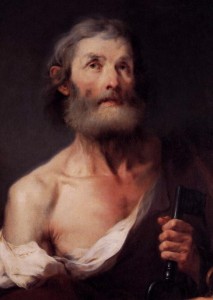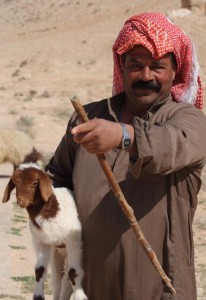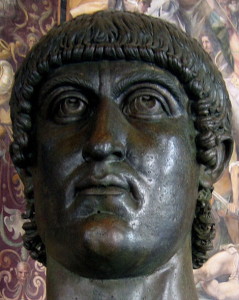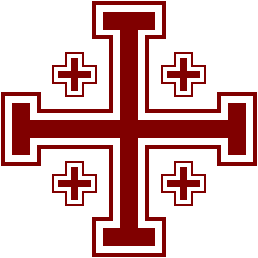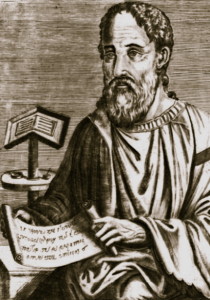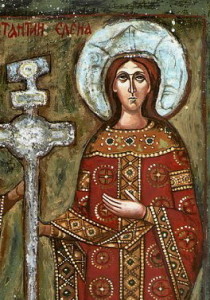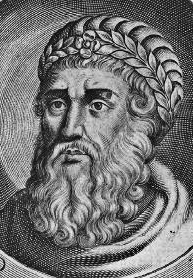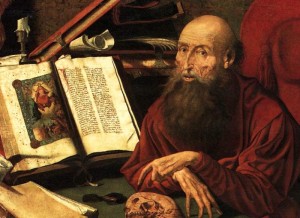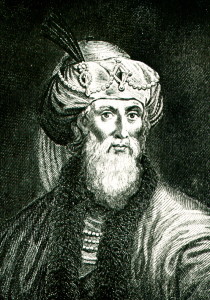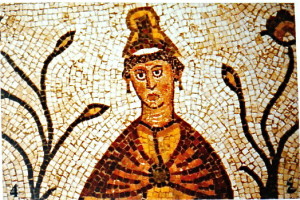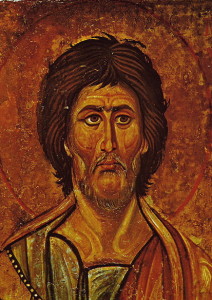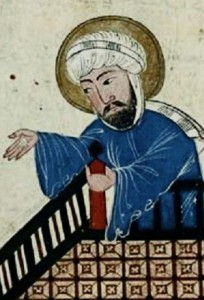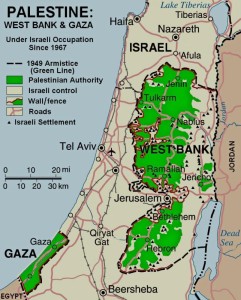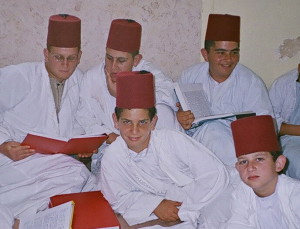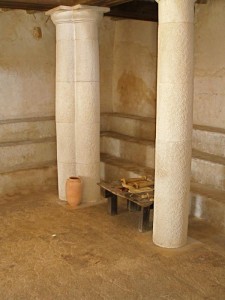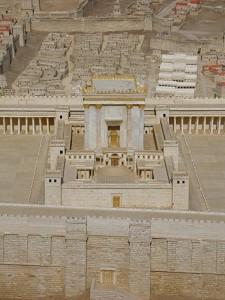The founding patriarch of the Israelites, Ishmaelites, Midianites and Edomite peoples, he is considered father of the three monotheistic faiths tied to the Holy Land today — Judaism, Christianity and Islam.
Genesis 17:5 says God changed his name from Abram (probably meaning “the father is exalted”) to Abraham (meaning “father of many”), then sent him from his home in Mesopotamia (present-day Iraq) to Canaan.
Here Abraham entered into a covenant: He would recognise Yahweh as his God, and in return he would be blessed with numerous offspring and the land would belong to his descendants.
The fifth book of the New Testament, it is traditionally ascribed to Luke the evangelist and is a sequel to his Gospel. It described the growth of the Christian Church during the 30 years after Jesus’ Ascension and especially the work of the apostle Paul.
The announcement by the archangel Gabriel to the Virgin Mary that she would become the mother of the Son of God, who would be named Jesus.
Most Christians celebrate the Feast of the Annunciation on March 25, nine months before Christmas.
Early religious books that are not accepted as belonging to the Bible (though, in spite of its usually negative connotation, apocrypha actually means “hidden” or “concealed”).
In particular, the Apocrypha refers to the books from the Greek translation of the Old Testament that are included in the Roman Catholic and Eastern Orthodox Bibles, but not in the Jewish or Protestant Bibles (although they were originally included in the 1611 King James Version).
In general, the term apocryphal is applied to any scriptural text that is excluded from a Bible. Since different denominations differ on what their Bible contains, there are different versions of the Apocrypha.
The word is also applied to texts of uncertain authenticity, or that may be fictional or spurious. These include several “gospels” and lives of the apostles.
One of the early missionaries of the Christian Church, especially one of “The Twelve”, the inner circle of disciples who had been chosen and trained by Jesus to spread his message. The word means “one who has been sent”.
Traditionally, The Twelve include Peter, Andrew, James the Greater, James the Lesser, John, Philip, Bartholomew, Matthew, Thomas, Thaddeus, Simon and Judas Iscariot (who was replaced by Matthias after Judas betrayed Jesus).
A language related to Hebrew and Arabic, and probably the mother tongue of Jesus. It was the language most people spoke in the villages and towns of Palestine and is the main language of the Jewish Talmud. Now it is the first language of scattered communities in several countries of the Middle East, and the language of worship in the Syriac Orthodox Church.
The scientific study of ancient civilisations, usually by excavating historical or sacred sites. It involves the discovery and interpretation of material remains left behind by those who lived there long ago. In the Holy Land it helps to re-create the environment and culture in which biblical events occurred. The first archaeological excavations in the Holy Land took place at Nineveh in 1842.
A wooden box, covered with gold, containing the stone tablets inscribed with the Ten Commandments. Carried by the Israelites on their Exodus journey through the desert, it represented the presence of God among his people and was the most sacred religious symbol of the Hebrew people. Eventually installed in the holiest chamber of Solomon’s Temple, it disappeared when Jerusalem was destroyed by the Babylonians in 587 BC.
A place name given in Revelation 16:16 as the location of the final battle in which good will triumph over evil.
The name comes from the Hebrew name Har-Megiddo, meaning “Mountain of Megiddo”. The mount of Megiddo is near the modern settlement of Megiddo, in northern Israel, situated at a strategic crossroads in the Jezreel valley and at the foot of the Carmel mountain range.
Invaders have fought battles here since ancient times.
The departure of Jesus from earth to heaven, 40 days after his Resurrection. Tradition locates the event on the top of the Mount of Olives in Jerusalem, at a place now marked by the Dome of the Ascension.
Christians celebrate the Feast of the Ascension on the Thursday of the sixth week after Easter.
One of the youngest of the world’s major religions, this monotheistic faith was founded by Mizra Hussein Ali, who became known as Bahá’u’lláh, in Iran in 1863. Its world headquarters is on Mount Carmel in Haifa.
The teachings of Bahá’u’lláh revolve around the principle of the oneness of humankind. The Baha’i faith accepts all religions as having true and valid origins.
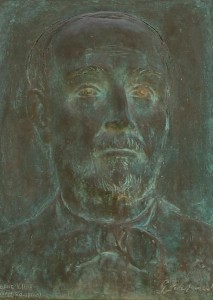
Antonio Barluzzi, relief displayed outside Church of the Transfiguration, Mount Tabor (Seetheholyland.net)Antonio
An Italian architect (1884-1960) who designed several of the most striking churches and sanctuaries in the Holy Land. These include the Church of All Nations at Gethsemane, Church of the Transfiguration on Mount Tabor, Chapel of the Angels at Shepherds’ Field, Church of the Visitation at Ein Karem, Church of Dominus Flevit on the Mount of Olives, and Church of the Beatitudes by the Sea of Galilee.
A prayerful man, he lived a humble life and meditated at length on the Gospels before undertaking any design. He always tried to make his buildings express the events they commemorated. Example are the teardrop-shaped Dominus Flevit church with tear phials on the four corners of its dome to recall Christ’s weeping over Jerusalem, and the Shepherds’ Field chapel shaped like a Bedouin tent.
Barluzzi’s lifetime dedication to building shrines in the Holy Land has led to the comment that in Israel there are three types of architecture: Graeco-Roman, Byzantine and Barluzzi. A bas-relief of the architect is set into a wall outside the Church of the Transfiguration on Mount Tabor.
A rectangular building divided by a central nave and side aisles, usually formed by rows of columns. Such public buildings in Rome served as centres of justice or administration. Architects adapted this form for Christian churches from the fourth century AD.
BC (Before Christ) and AD (Anno Domini, meaning “in the Year of Our Lord”) indicate years in the Julian and Gregorian calendars. The reference year is the birth of Christ but there is no year 0, so 1 BC is immediately followed by AD 1.
This usage was developed in the 6th century AD by a scholarly monk called Dionysius Exiguus (Denis the Little). Dionysius established what he thought was the year of the birth of Jesus, but he was out by at least four years. Scholars now believe that Jesus was born between 4 and 7 BC.
BCE (meaning Before the Common [or Christian] Era) and CE (Common [or Christian] Era) are secular designations for the same numbering system.
Jews, who in any case have their own Hebrew calendar, do not normally use BC and AD.
Desert-dwelling and Arabic-speaking nomads who inhabit much of the Middle East and northern Africa. Bedouin have traditionally made their living by animal husbandry, those herding camels being best known.
Since many governments have nationalised their traditional range lands, many have now settled in Israel and other countries.
The accepted collection of sacred books of Judaism and Christianity, divided into Old and New Testaments. However, Protestants and Jews on the one hand, and Roman Catholics and Orthodox Christians on the other, differ on which books belong in the Old Testament.
Jewish rabbis finalised their collection of holy books (the Hebrew Bible) by the end of the first century AD. They included only books written in Hebrew or Aramaic and excluded those originally written in Greek (though original Hebrew versions of some have since been found).
The early Christian Church drew up its first listing of texts accepted as authentically inspired in the 4th century. It included several books that were part of the Greek Old Testament from pre-Christian times (including Judith, the Wisdom of Solomon and 1 and 2 Maccabees).
The word Bible is derived from the Greek “biblia” (the books). The traditional division of chapters was made in the 13th century, and the numbering of verses in the 16th century.
Following the Jewish tradition, the Protestant reformers of the 16th century rejected the Greek Old Testament books, ranking them among those texts of uncertain authenticity called the Apocrypha, a word actually meaning “hidden” or “concealed”.
The Bibles of the Eastern churches include some books not accepted in the Catholic and Protestant Bibles. Other “apocryphal” texts are not included in any Bible.
A style of architecture, art and cultural influence arising from the ancient city of Byzantium (later renamed Constantinople and now Istanbul). From about AD 330 until 1453, this city replaced Rome as the capital of the Roman Empire and major governing force of the Mediterranean world.
The land God promised to the descendants of Abraham. Though various boundaries are given in the books of Genesis and Exodus, the Promised Land apparently encompassed present-day Israel, Palestine and Lebanon, plus parts of Jordan, Syria and Egypt.
In Leviticus 25:23 God tells Moses the land still belongs to him and the Israelites are “but aliens and tenants”. In Deuteronomy 30:18 Moses tells the Israelites that continued possession of the land depends on “holding fast” to God.
Apart from being a group of singers, the choir in church architecture is the area between the transept and the main apse. This is where stalls for the clergy or liturgical singers are placed.
A receptacle for liquids, usually a hole dug in the ground to collect and store rainwater. Cisterns are frequently mentioned in the Bible, because of the Holy Land’s scarcity of springs and infrequent rain.
Emperor of Rome from AD 306 to 337, who is best known for being the first Roman emperor to become a Christian. He ceased persecutions of Christians and granted freedom of religion within his empire.
During a building campaign overseen by his mother, St Helena, he built many churches in the Holy Land, including the original Church of the Holy Sepulchre in Jerusalem and Church of the Nativity in Bethlehem.
A series of military campaigns from Christian Europe in the Middle Ages to regain control of the Holy Land from Muslim rule and resume safe access for pilgrims. There were nine Crusades over a period of 200 years, beginning in 1095.
Crusaders captured Jerusalem in 1099. Their Kingdom of Jerusalem fell after a decisive defeat by the sultan Saladin in 1187 at the Horns of Hattin, overlooking the Sea of Galilee. The Crusaders’ last stronghold, Acre, survived until 1291.
The excesses of the Crusaders sowed seeds of mistrust between East and West that still remain. But historians also recognise the enormous contribution the Crusades made to exchanges in trade, culture, scholarship and technology between Europe and the Middle East.
For pilgrims and tourists, the Crusaders left a vast legacy of castles, churches and fortifications in the Holy Land.
An agency of the Catholic Church that administers and maintains 50 sacred sites in Israel, Jordan and Syria. Part of the international Franciscan religious order, its brown-robed friars are a familiar site in the holy places.
The custody (also known by its Latin name, Custodia Terrae Sanctae) has had a presence in the Holy Land since early in the 13th century. Its founder, St Francis of Assisi, travelled through Egypt, Syria and Palestine in 1219 and 1220.
Its role encompasses prayer and worship in the holy places, service to local Christians, and hospitality to pilgrims (including guesthouses and spiritual support). It also provides guides for pilgrimage groups and runs the Christian Information Centre just inside the Jaffa Gate in Jerusalem.
The symbol of the Franciscan custody is the Jerusalem Cross. It consists of an heraldic cross with crossbars, surrounded by four smaller crosses. The smaller crosses are variously said to symbolise either the four Gospels or the four directions in which the Christian message spread from /jerusalem/. The five crosses together are seen to symbolise the five wounds of Christ.
A grouping of 10 cities in Palestine and the Transjordan, founded by Alexander the Great and his successors around 323 BC.
They were Scythopolis/Beit She’an (the capital), Hippos, Philadelphia (modern Amman), Gerasa (Jerash), Gadara, Pella, Dion, Canatha, Raphana and Damascus.
The Decapolis was one of the few areas visited by Jesus in which Gentiles were in the majority.
Members of a strict and highly organised Jewish sect that flourished at the time of Jesus. Apparently formed in reaction to what they saw as religious laxity in Jerusalem, they lived an austere lifestyle and encouraged celibacy.
The Dead Sea Scrolls found at Qumran are believed to have belonged to a community of Essenes. The sect ceased to exist during the 2nd century AD.
Bishop of Caesarea in the early 4th century and prolific author of histories, apologetic and theological works, and biblical commentaries.
Eusebius of Caesarea (c.260-339) is regarded as the father of Church history. His Church History is the principal primary source on the rise of Christianity during its first three centuries.
Another surviving work, the Onomasticon, is an alphabetical dictionary of biblical place names, often identifying locations with places existing in Eusebius’ own lifetime.
The deportation of many of the inhabitants of Jerusalem and Judaea to Babylonia (in present-day Iraq) during the 50 years from 587 BC.
The escape of the Israelites from slavery in Egypt under the leadership of Moses. The central event of the Hebrew Bible, the Exodus is also a model for subsequent experiences of liberation in biblical, Jewish, Christian and Muslim traditions.
The Exodus entails not only the events in Egypt but also those encompassed within the period from Moses to Joshua, including the wilderness wanderings and the conquest of the land of Canaan.
A name originally given in the Middle East to Christians from western Europe, in particular the French who dominated the Crusader Kingdom of Jerusalem, and subsequently to the Franciscans who were seen as their successors.
A reminder of the name survives at the Church of the Holy Sepulchre. A small chapel at the top of the stairway to the right of the entrance is called the Chapel of the Franks, meaning Chapel of the Franciscans.
A Latin word meaning “cock-crow”. The Church of St Peter in Gallicantu, on the eastern slope of Mount Zion in Jerusalem, commemorates Peter’s triple rejection of Jesus “. . . before the cock crows twice”.
The first shrine dedicated to Peter’s repentance was erected here in AD 457. A golden rooster stands on the roof of the present church, completed in 1932.
The entry point to a walled city. This key element in a city’s defences was also the hub of civic and commercial activity. It often incorporated watchtowers and chambers for official business, sometimes including a judge’s seat where lawsuits were heard.
A term used in the Second Temple period (516 BC to 70 AD) to refer to non-Jewish people. In New Testament times it was applied both to non-Jews and non-Christians.
After some controversy, the early Christian leaders decided that gentiles too, not only Jews, could become Christians. St Paul is referred to as the apostle to the gentiles, both in the Acts of the Apostles and in his own letters.
The message of Jesus Christ and the salvation he brought to humankind. The word comes from the Anglo-Saxon “godspell”, meaning good news.
This name is also given to each of the first four books of the New Testament, which deal with Jesus’ life, death and Resurrection. The Gospels of Matthew, Mark, Luke and John are believed to have been written between AD 65 and 100.
The oldest is probably the Gospel of Mark, which tradition says was written in Rome by John Mark, who recorded St Peter’s teachings. The Gospels of Matthew, Mark and Luke are called “synoptic” Gospels because they follow a common synopsis or outline and can be studied in parallel.
A Semitic language written from right to left with an alphabet of 22 letters. Originally only consonants were used, but vowels were later introduced.
Hebrew died out as a vernacular language in Palestine, probably in the late 2nd or 3rd century AD, but continued to be used by Jews for prayer and study.
Revived in the late 19th century, it is now (along with Arabic) an official language of Israel.
Mother of the emperor Constantine, she instigated several major churches in the Holy Land and is credited with finding the True Cross.
Helena (c.250-330) was a servant girl who became either the concubine or wife of the emperor Constantius, who later abandoned her for political reasons. Her son Constantine named her Augusta (majestic) when he became emperor in 306.
She became a Christian and, with Constantine’s encouragement and financial backing, made a pilgrimage to the Holy Land around 326. There she ordered churches built on several holy sites.
They included the Church of the Nativity in Bethlehem; the Church of the Holy Sepulchre on the site of Calvary and the Tomb of Christ; and the Eleona Church (destroyed by the Persians in 614) on the Mount of Olives.
Helena is considered a saint by the Eastern Orthodox, Oriental Orthodox and Roman Catholic churches. Her palace in Rome was converted into the basilica of Santa Croce in Gerusalemme (Holy Cross in Jerusalem).
A Rome-appointed client-king of Israel. Known for his colossal building projects and his brutality, he is usually called Herod the Great to distinguish him from other members of the dynasty he established.
Herod (74-4 BC), an Idumaean by birth, identified himself as a Jew but maintained a decadent lifestyle. He was named “King of the Jews” by the Roman senate around 40 BC.
He rebuilt the Second Temple in Jerusalem, the Mediterranean seacoast city of Caesarea and the fortress of Herodium (where he was buried).
He ordered the killing of the Holy Innocents at Bethlehem and executed several members of his own family, including one of his several wives and two of his sons.
Three of his sons inherited his name and parts of his kingdom. The most notable was Herod Antipas, who had John the Baptist executed. It was to Herod Antipas that Pontius Pilate sent Jesus for questioning, and whose soldiers mocked Jesus.
The spread of Greek language, culture and religion through the Middle East, south-west Asia and north-east Africa during the dominant period of the Greek empire. Most Jews in Palestine resisted this influence on religious grounds.
A portrait or image, usually representing Christ or a saint, painted on a wooden surface. Icons are especially venerated by Eastern Christians.
In strict terminology, icons are “written”, not painted. The traditional technique uses egg-tempera on solid wood panels, with prayer and contemplation at each step of the process.
A screen in Eastern churches that separates the area around the altar from the main body of the church. It is hung with icons and typically has three openings or doors.
The central Christian belief that the Son of God took flesh and became a man in the form of Jesus. The word refers both to the event by which Jesus was conceived in the womb of the Virgin Mary, and to the ongoing reality of Jesus being fully human and fully divine.
The religious faith of Muslims, founded by Muhammad and based on the teachings of the Qur’an, a book considered to have been divinely revealed to Muhammad by the archangel Gabriel.
Islam means “to submit” oneself to the will and grace of God, who is called Allah in Arabic. A monotheistic religion, it is the most populous faith in the world after Christianity.
A Dalmatian-born priest and scholar (c.347-420) who lived in the Holy Land for more than 36 years and is best known for his translation of the Bible from Hebrew and Greek into Latin.
Jerome was encouraged to undertake his translation project by Pope Damasus I, for whom he served as secretary. In 386 he moved from Rome to Bethlehem, where he lived and worked in a two-room cave. St Jerome’s Cave can still be visited under the Church of the Nativity.
The translation he completed, known as the Vulgate, remained the authoritative version of the Bible for Catholics until the 20th century. The Catholic and Eastern Orthodox churches recognise him as a saint.
Jerome (also known as Hieronymus, the Latin version of Jerome) was known for his ascetic lifestyle and his passionate involvement in doctrinal controversies.
A Jewish historian (37-c.100) who became a Roman citizen and, while enjoying the patronage of the ruling Flavian dynasty in Rome, wrote the most important contemporary accounts of first-century Judaism and the background of early Christianity.
Born Joseph Ben Matityahu, he fought against the Romans in the Jewish revolt of 66-73 as commander of the Jewish forces in Galilee.
When Jotapata, in northern Galilee, fell to the Romans after a bloody battle in 67, Josephus and 40 companions were trapped in a cave. All made a pact to commit collective suicide by killing each other, one by one. One of the last two men standing — “should one say by fortune or by the providence of God?” — was the wily Josephus, who persuaded his companion to join him in surrendering.
Then, according to Josephus’ own account, he ingratiated himself with the Roman commander, Vespasian, by predicting that Vespasian would become emperor — as he did two years later.
A collective community in Israel, originally based on agriculture but now encompassing other industries including hotels. A member of a kibbutz is called a kibbutznik.
There are about 250 kibbutzim (the plural form) in the country. Though they began as a blend of socialism and Zionism, most have now been privatised and no longer practise communal living.
Food fit for consumption according to Jewish dietary laws, many of which are derived from the books of Leviticus and Deuteronomy.
These laws exclude mammals such as pigs that do not both chew their cud and have cloven hooves. Fish must have skins and scales (so shellfish are excluded).
Mammals and birds must be slaughtered in a specific way and by a trained individual, and as much blood as possible must be drained or broiled out of it (because consumption of blood is forbidden).
Meat must not be eaten with dairy products or cooked using the same utensils (observant Jews have separate sets of utensils for meat and milk).
Wine and other grape products must be made by Jews (a restriction that derives from laws against consuming products used in idolatry).
A prescribed form of public worship practised by a specific religious group, according to its traditions. The origin of the word is a Greek composite meaning a service to the state undertaken by a citizen as a public duty.
In Judaism this may centre on the reading from the Torah. In Eastern Christianity it is the Eucharist, but in Western Christianity it also encompasses other rites and ceremonies that are part of the public worship of God, as opposed to private devotions.
Worship services in the Middle East, where Christian liturgy first developed, tend to be more elaborate — with more bells, candles and incense, and longer prayers — than Western Christians are accustomed to.
Also known as the Our Father or (in Latin) Pater Noster, it is the simple and spontaneous prayer taught by Christ to his disciples as a model of how to pray. Two versions are given in the New Testament, one in Matthew 6:9-13 and the other in Luke 11:2-4.
Probably the best-known prayer in Christianity, it is also the principal prayer used by Christians in common worship.
According to a long tradition, the Church of Pater Noster on the Mount of Olives in Jerusalem stands over a cave in which Jesus taught this prayer. Around the church and its vaulted cloister, translations of the Lord’s Prayer in 140 languages are inscribed on colourful ceramic plaques.
A person who voluntarily accepts being put to death rather than deny his or her religious beliefs. Originally the word signified a witness who testified to a fact of which he or she had knowledge from personal observation.
Hebrew for “anointed one”, especially one commissioned for a special role. In Jewish tradition it denotes an expected or long-for saviour. In Christianity it means Jesus, to whom the name “Christos” (anointed in Greek) becomes part of his name.
Jewish tradition envisioned that God would send a saviour from the line of King David to deliver his people from suffering and injustice. The idea that this saviour would suffer appears in numerous psalms attributed to David.
A bath or pool, constructed as part of a building, used by Jews for immersion to cleanse from ritual impurity. Many ancient examples have been found in Israel.
The authoritative collection of rabbinical oral tradition on various topics of Jewish law, compiled early in the 3rd century AD at Sepphoris.
An art form in which small cut pieces of stone, coloured glass or other materials are laid on a surface to create pictures, geometric patters or inscriptions.
Each cut piece, normally roughly cubic, is called a tessera (plural tesserae). Some mosaics contain hundreds of thousands of tesserae.
Wall, ceiling and floor mosaics, often elaborate, are found in churches throughout the Holy Land.
The word Mosaic is also used to indicate an association with Moses, such as the Mosaic Law found in the Torah.
The pre-eminent leader and lawgiver of the Jewish people, who led the Israelites in their Exodus from Egypt and their journeyings in the wilderness. During this time, the Bible says, he received the Ten Commandments from God.
But God did not allow Moses to enter the Promised Land. Instead, he viewed it from the top of Mount Nebo, then died at the age of 120. His burial place is unknown.
Jewish religious tradition regards Moses as the author of the Torah, the first five books of the Hebrew Bible. He is also revered as an important prophet by Christians, Muslims and members of the Baha’i and other faiths.
A place of worship for followers of Islam, and usually also a meeting place and focal point for the local Muslim community.
Distinctive features often include grand entryways and tall slender towers, or minarets, from which an official called a muezzin (or a recording) summons the worshippers to prayer five times a day.
There are no chairs or seats. The floor is often covered with expensive carpet. Visitors must remove their footwear — not as a sign of respect, but to protect the carpet.
Statues or pictures are not permitted; the only decorations are usually Arabic calligraphy and verses from the Qur’an, the Muslims’ holy book.
In one wall is a mihrab, a niche indicating the direction of Mecca. Near it is the minbar, a seat at the top of steps, used by the preacher as a pulpit. A place for ablution is usually attached to the mosque.
Women may take part in prayers, but they occupy a separate area.
The founder of the Islamic faith, regarded by Muslims as the last and greatest prophet of God. His name is sometimes spelt Mohammed or Mohamet.
Born in Mecca (now in Saudi Arabia) around 570, Muhammad became a successful merchant. When he was 40, according to Muslim tradition, he was visited by the archangel Gabriel, who informed him that he was a messenger of God. Subsequent revelations, recorded in the Qur’an, are the basis of Islam.
Muhammad’s public preaching on the duty to submit to one true God provoked enemies. In 622 he was forced to flee for his life to Medina. Mohammad’s followers finally conquered Mecca and all of Arabia in 630, two years before he died.
The collection of 27 books that forms the second section of the Christian Bible. These books, telling the story of Jesus Christ and his apostles, and of the early Church, are the most important writings for Christians.
They consist of the Gospels of Matthew, Mark, Luke and John; the Acts of the Apostles, also attributed to Luke; the letters of Paul and several other writers; and the prophetic book of Revelation (or Apocalypse).
The collection of books that forms the first section of the Christian Bible. It is similar to the Hebrew Bible, but with some variations.
The Old Testament describes God’s dealings with the Jews as his chosen people. It includes books of history, laws, theology, wisdom, prophecy and poetry.
Christian churches differ on the number of books they accept as belonging to the Old Testament. The Orthodox churches generally accept 51 books, the Catholics 46, and the major Protestant denominations 39.
The churches of Eastern Europe and the Middle East that were divided from the Roman Catholic Church after the Great Schism of 1054.
The split along doctrinal, theological, linguistic, political and geographic lines divided medieval Christianity into Eastern (Greek) and Western (Latin) branches. The word Orthodox in Greek (orthos + doxa) means “correct belief”.
The Eastern Orthodox communion now consists of 14 or 15 self-governing churches and 5 others whose leader must be confirmed by a mother church. Those in the Holy Land include the Greek, Armenian, Russian, Coptic, Syriac and Ethiopian Orthodox.
Many have counterparts that have returned to union with Rome, but retain their own distinctive ritual, language and culture. These are called Eastern-Rite Catholic churches.
Also see Churches in the Holy Land
A stone box in which the bones of a dead person were placed after the flesh had decayed.
From the 1st century BC until about AD 70, because space in tombs was scarce, Jews customarily buried their dead in a tomb for a year, then collected the bones and placed them in an ossuary.
Among the ossuaries that have been discovered, particularly in the Jerusalem area, some are decorated with carvings and inscriptions identifying the deceased.
A Muslim military administration, based around the Turkish sultan, that ruled much of the Middle East as well as parts of North Africa and the Balkans in Europe from 1299 until 1922. It was succeeded by the modern Republic of Turkey.
At the height of its power, in the 16th and 17th centuries, it encompassed most of southeastern Europe up to the gates of Vienna; Iraq, Syria, Palestine and Egypt; North Africa as far west as Algeria; and most of the Arabian Peninsula.
Historically, this is the region that stretches from the Jordan River valley to the Mediterranean Sea. It is named after the Philistines, who settled on the coastal strip of Canaan.
To Jews it incorporates their Promised Land; to Christians it is the land of Jesus Christ and the birthplace of the Christian Church; to Muslims it contains the city of Jerusalem, which they call Al-Quds (“the Holy”).
In geographic terms, Palestine includes Israel and the Israeli-occupied Palestinian territories (the West Bank and Gaza), and parts of both Lebanon and Syria.
The name was used for this region as far back as the 5th century BC by the Greek historian Herodotus. Later references were by the Greek philosopher Aristotle and the Jewish scholar Philo of Alexandria — a contemporary of Jesus.
Since prehistoric times, the occupiers of Palestine have included Canaanites, Jebusites, Hebrews, Babylonians, Persians, Greeks, Romans, Byzantines, Arabs, Crusaders, Turks, Egyptians and British.
During the 1948 Arab-Israeli War, many inhabitants of Palestine fled to the West Bank (of the Jordan River), to Jordan, Lebanon and other Arab countries. Many more have emigrated since, often to Europe or the Americas.
In 2012 the United Nations General Assembly accepted Palestine as a “non-member observer state”.
An everyday story told to convey a moral or religious lesson. The word comes from the Greek “parabole”, which means the placing of two things side by side for the sake of comparison.
The Gospels report many parables of Jesus, in which he used settings and events from daily life in Palestine (such as the sowing of seeds) to convey lessons he wished to teach.
Originally probably a spring festival of nomadic tribes, it came to celebrate the Israelites’ Exodus from slavery in Egypt. The name comes from the action of the angel of death who “passed over” the homes of the Hebrews when he killed the firstborn of every Egyptian family.
The Passover meal, of lamb or goat with unleavened bread and bitter herbs, was eaten in haste, with the participants dressed as for imminent departure.
For modern Jews, the feast of Passover (known as Pesach) is the one most widely observed. It begins with the ritual meal (called the Seder) and lasts seven days in Israel and eight days outside Israel.
Because Jesus used a Passover meal for his Last Supper, at which he instituted the Eucharist, this Jewish feast was taken over into the Christian Easter celebration.
The male head of a tribe or family. In the Old Testament it refers particularly to Abraham, Isaac and Jacob, the patriarchs through whom God made his covenant with his people.
In Christian times patriarchs are usually considered the successor to an apostle in a church he established. The patriarch of the West is the Pope, as successor to St Peter. The patriarch of the East is the Orthodox Ecumenical Patriarch of Constantinople, as successor to St Andrew.
In Jerusalem the major Christian churches each have a patriarch. The roads that lead to their residences in the Christian Quarter are named Greek Orthodox Patriarchate Road, Latin Patriarchate Road, etc.
This feast, along with Passover and Sukkoth, was one of the three great pilgrimage feasts which brought Jews to the Temple.
Originally an agricultural festival marking the end of the spring barley harvest and the beginning of the summer wheat harvest, it celebrates the giving of the Torah by God to Moses.
In the New Testament, Pentecost brought the fulfilment of Jesus’ promise that he would send the power of the Holy Spirit upon his apostles.
A party or sect within Judaism, who zealously upheld strict compliance with religious laws, both written and oral. They also interpreted the law to meet changing conditions.
Jesus condemned them for hypocrisy and blindness, and for laying heavy burdens on others’ shoulders, “but they themselves are unwilling to lift a finger to move them” (Matthew 23:4).
As governor of Judea he presided at the trial of Jesus and, despite saying he found no fault in him, handed him over for crucifixion.
Pilate was based at Caesarea Maritima, but came to Jerusalem with his troops to keep order during the Passover. Few biographical facts are known, but in 1961 a limestone block bearing his name was found in the Roman theatre at Caesarea.
In the end Pilate lost the support of the Jewish leaders and he was eventually removed by Rome because of his cruelty and oppression.
A person who speaks or acts on behalf of God. The prophet’s task is not so much to predict the future as to pronounce God’s will.
In the Old Testament, a great diversity of men and women, often reluctantly, undertook this role. They spoke to individuals, groups and even the whole nation, often suffering humiliation and threats as a consequence.
In the New Testament, Jesus was seen as the prophet who would initiate God’s renewal of all things. There were also prophets in the early Christian communities, and since then many holy people have been regarded as exercising the gift of prophecy.
The land God promised to the descendants of Abraham. Though various boundaries are given in the books of Genesis and Exodus, the Promised Land (also known as Canaan) apparently encompassed present-day Israel, the Palestinian Territories and Lebanon, plus parts of Jordan, Syria and Egypt.
In Leviticus 25:23 God tells Moses the land still belongs to him and the Israelites are “but aliens and tenants”. In Deuteronomy 30:18 Moses tells the Israelites that continued possession of the land depends on “holding fast” to God.
Also spelt Koran, this is the most holy book in Islam. Muslims believe it was dictated by the archangel Gabriel to Muhammad.
The book is about two-thirds the length of the New Testament and contains 114 chapters (or surahs). Only the Arabic original is considered to be the authentic text.
Jesus is referred to as a messenger and prophet of God, but a human being and not God incarnate. His mother Mary is the only woman mentioned by name in the Qur’an. She receives a whole chapter, and the virgin birth of Jesus is acknowledged.
The Islamic month of fasting, in which Muslims may not eat or drink anything, including water, while the sun shines. Ramadan is also a time of increased worship and prayer.
The third “pillar” or religious obligation for Muslims, fasting is seen as a means of coming closer to God, as well as teaching self-control and patience. In the Muslim world, most restaurants are closed during daylight hours throughout Ramadan.
Ramadan is the ninth month of the Islamic calendar. Because Islamic months are based on sightings of the new moon, Ramadan occurs about 11 days earlier each year on the Western Gregorian calendar.
Muslims believe that the first verses of the Qur’an were revealed to Muhammad during the month of Ramadan.
The Resurrection of Jesus Christ after his death by crucifixion is the central doctrine of the Christian faith.
Christians believe that God the Father raised Jesus to new life as Lord with all authority in heaven and on earth, and that those who have entered into his death and Resurrection by baptism will be raised and glorified with him at the end of time.
Known as Shabbat to Jews, it is the seventh day of the week, set aside for rest and the worship of God as a reminder of the Creation and the Exodus from Egypt.
The Sabbath is observed from sundown Friday until three stars are visible in the sky on Saturday evening. Jewish law prohibits 39 categories of activity on the Sabbath, including the use of electricity or a motor vehicle, except when necessary to save human life.
The early Jewish Christians kept the Sabbath, but soon began to observe Sunday, the day of the Resurrection, as the Lord’s Day. By the 4th century, Sunday had become the Christian day of worship and rest from work.
A Jewish party, mainly from the great priestly families and aristocracy, that held power in Jerusalem and was concerned particularly to uphold the Temple and its rituals.
They insisted on strict adherence to the written Law of Moses and opposed any interpretation of it. They rejected belief in angels or in the resurrection of the body.
The New Testament depicts them as opponents of Jesus who tested him with questions.
An ethnic and religious group who believe they descend from the remnant of the northern Israelite tribes who avoided deportation by the Assyrians in 722 BC.
Several hundred Samaritans still survive, preserving their ancient rites on their holy site of Mount Gerizim, near the modern West Bank city of Nablus. They accept only the first five books of the Old Testament, containing the Mosaic Law.
In the New Testament, when Jesus’ disciples expressed typical Jewish animosity towards the Samaritans he rebuked them. Jesus also gave Samaritans positive roles in his parables, notably the parable of the Good Samaritan (Luke 10:30-37).
A stone coffin. Usually designed to be freestanding above ground, these were often ornately carved and decorated.
A market, either outdoor or covered, or a commercial quarter, in an Arab or Muslim city. Often a wide variety of goods, from food to livestock, are on sale.
A series of 14 events from Jesus’ journey to Calvary on Good Friday. These are often represented by art in churches, or by outdoor sculptures, to assist meditation on his Passion.
The Stations of the Cross originated with pilgrimages to Jerusalem. By the 5th century the practice of reproducing the “stations” of the Passion was popular in Europe.
The number of Stations and the events represented has varied from 7 to 18 or more. Of the present 14 Stations, 9 are based on Gospel accounts and 5 — Jesus’ meeting with his mother, Veronica wiping his face, and his three falls — on popular tradition.
In Jerusalem, pilgrims recall these events as they walk along the Via Dolorosa.
A set of detailed and binding arrangements covering possession, usage and ceremonies at major holy places, originally laid down by a Turkish sultan in 1757. It is not an agreement between the churches.
The Status Quo applies particularly to the rights of the Greek Orthodox, Roman Catholic and Armenian Orthodox churches in the Church of the Holy Sepulchre, Jerusalem, and the Church of the Nativity, Bethlehem. It also covers the Dome of the Ascension and Tomb of Mary in Jerusalem.
Control of the major holy places was in the hands of Catholic Franciscans for 300 years up till 1662. It was contested by Catholics and Greek Orthodox in courts and corridors of power up till 1757, when Greeks launched a surprise Palm Sunday takeover and Ottoman Turkish Sultan Abdul Hamid I confirmed their right of possession.
By the mid-19th century, Sultan Abd-ul-Mejid I faced international pressure over the holy places from France (for the Catholics) and Russia (for the Orthodox). Russia even threatened to invade Turkey.
To defuse the situation he issued a firman (decree) in 1852 declaring that “The actual status quo will be maintained and the Jerusalem shrines, whether owned in common or exclusively by the Greek, Latin, and Armenian communities, will all remain forever in their present state.”
In 1878, the Treaty of Berlin incorporated the Status Quo into international law.
An upright slab of stone or wood, engraved with an inscription or design. Steles (or stelae) were used to commemorate important events, such as military victories; to extol the accomplishments of rulers; or to mark territories.
A covered walkway or portico, with a row of columns along its open front. Some were of two storeys.
Markets were often located in stoas (or stoae). The magnificent Royal Stoa along the southern wall of the Temple Mount in Jerusalem may have been the place where Jesus overturned the tables of the money-changers (Matthew 21:12).
A Jewish place of Sabbath worship and for religious study, but not for sacrifices. After the destruction of the Second Temple in AD 70, synagogues became the focal point of Jewish community life.
A typical synagogue contains an ark in which the scrolls of the Mosaic Law are kept, an “eternal light” burning before the ark, a raised platform on which services are conducted, and sometimes a mikveh (ritual bath).
The central text of Jewish law and teachings. It contains interpretation of, and commentary on, the Torah — the primary source of Jewish religious law.
There are actually two Talmuds, developed by different groups of Jewish scholars in Babylonia (c. AD 600) and in Israel (c. AD 400). The more extensive Babylonian Talmud is more highly regarded.
An archaeological term for a mound or hill containing the remains of successive layers of human settlement.
“Tel” is the modern Hebrew spelling and “tell” the modern Arabic spelling. Both are used in placenames, such as in the Israeli city of Tel Aviv and the archaeological site of Tell es-Sultan at Jericho.
The central place of Jewish worship and the only place where sacrifices could be made, the Temple in Jerusalem was seen as the dwelling-place of God in the midst of his people.
The First Temple was erected by Solomon (c.960 BC) and destroyed by the Babylonians in 587/586 BC. The Second Temple, built by Jews who returned from exile in Babylon, was completed in 515 BC.
The Second Temple was enlarged and refurbished by Herod the Great (c.20 BC) and it became known as Herod’s Temple. This rebuilt temple (sometimes referred to as the Third Temple) was the one Jesus knew. It was destroyed by the Romans in AD 70.
Both temples were on the Temple Mount, approximately on the present site of the Dome of the Rock.
The Western Wall, a section of the retaining wall that surrounded the Temple compound, is venerated by Jews as the only remnant of the Second Temple. The Jewish practice of mourning the destruction of the Temple led to its being called the Wailing Wall.
The first five books of the Hebrew Bible — Genesis, Exodus, Leviticus, Numbers and Deuteronomy — which are also called the Pentateuch. The word Torah can also refer to the entire body of Judaism’s founding teachings and traditions.
The five books of the Pentateuch are also accepted as the first five books of the Christian Old Testament.
The revelation of the glory of Jesus Christ as the Son of God, which the Gospels say took place on a “high mountain” in the presence of the apostles Peter, James and John.
The event is described in the Gospels of Matthew (17:1-8), Mark (9:2-8) and Luke (9:28-36). Matthew says Jesus’ “face shone like the sun, and his clothes became dazzling white” and Moses and Elijah appeared talking with him.
The mountain is traditionally identified as Mount Tabor, though some scholars argue it was probably Mount Hermon.
A fundamental doctrine of the Christian faith, signifying that in the unity of the Godhead there are three distinct Persons — Father, Son and Holy Spirit
The Qur’an of Islam misinterprets this doctrine by assuming that Christians worship the Father, Son and Virgin Mary as three gods.
The Latin version of the Bible translated by St Jerome from Hebrew and Greek at the end of the 4th century.
Jerome, a scholarly Dalmatian priest, spent 30 years on the project, working in a cave underneath the Church of the Nativity in Bethlehem.
An Arabic word for a deep gully or valley that is normally dry but contains water during the winter rainy season.
Wadis are common in Middle Eastern deserts and often give rise to placenames, such as Wadi Musa (Valley of Moses) near Petra in southern Jordan.
A landlocked Palestinian territory between Israel and Jordan on the West Bank of the Jordan River. To the west, north and south it borders the state of Israel. (Also see Palestine.)
Israel captured the disputed territory from Jordan in the 1967 Six Day War and refers to it by the biblical names of Judea and Samaria.
Most of the West Bank has been under Israeli military occupation since 1967, but since 1994 a limited degree of Palestinian Authority self-rule has existed in some areas.
The largest cities in the West Bank are Hebron, Nablus, Bethlehem and Jericho.
The personal name of the one true God, the God of Israel, as revealed to Moses. The meaning eludes scholars, though God described himself to Moses as “I am who I am” (Exodus 3:14).
Later Jews regarded the name as too sacred to be spoken, so only the consonants YHWH were written and the name was usually pronounced Adonai (“Lord”).
Early translators combined the consonants of Yahweh with vowels from Adonai to produce Jehovah, the name for God used in some early English Bibles.
In 2008 the Vatican directed that prayers and songs in Catholic liturgy should no longer use the word Yahweh, which was never pronounced by early Christians.
Also known as the Day of Atonement, this is the most solemn festival in the Jewish religious calendar. A day of fasting and repentance, it is considered a time of spiritual accounting and is observed even by many secular Jews.
Yom Kippur is a public holiday in Israel. Public transportation ceases, businesses close, and even private driving or eating in public are frowned upon.
A Jewish faction which sought to incite rebellion against the occupying Roman forces and expel them from Palestine. Zealots were prominent during the First Jewish Revolt in AD 66-70, which resulted in the destruction of Jerusalem.
One of the Twelve Apostles was called Simon the Zealot. This does not necessarily mean he was a member of the Zealots, since he was also called Simon the Cananaean, another word meaning zealous or ardent.

